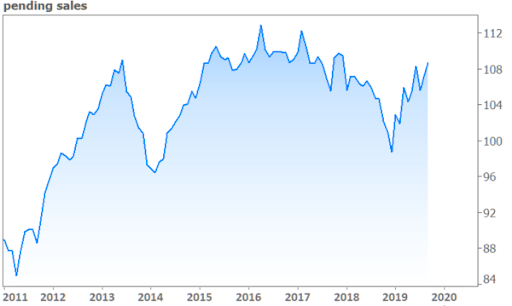Pending home sales posted a solid increase for the second straight month in September, more than doubling analysts' expectations. The National Association of Realtors® (NAR) said its Pending Home Sales Index (PHSI) rose to 108.7 from 107.3 the previous month, a gain of 1.5 percent. The results were 3.9 percent higher than in August 2018 and marked the fourth time the index increased in the last five months. The PHSI, a measure of contracts signed for the purchase of existing homes, is a leading indicator of future sales. Contracts are generally expected to become final within one to two months.
The PHSI increased by 1.6 percent in August and analysts, while primarily expecting sales to increase, had forecast in a range of -0.8 percent to a 1.0 percent gain. The consensus of those polled by Econoday was 0.7 percent.

Historically low mortgage rates played a significant role in the two straight months of gains, according to Lawrence Yun, NAR's chief economist. "Even though home prices are rising faster than income, national buying power has increased by 6 percent because of better interest rates," he said. "Furthermore, we've seen increased foot traffic as more buyers are evidently eager searching to become homeowners."
Although contract signings are on the upswing, Yun says the numbers would be even greater if more housing were available. "Going forward, interest rates will surely not decline in a sizable way, so the changes in the median price will be the key to housing affordability," he said. "But home prices are rising too fast because of insufficient inventory."
Yun advocates that builders should explore greater utilization of modular factory constructed homes to supplement traditional home building. Converting old shopping malls and vacant office space into residential condos, permitting more accessory dwelling units, and other supply-increasing actions are needed to meet the rising demand for new housing.
Regional indices in September were mixed, with the Northeast experiencing the smallest change of the four regions. The PHSI in that region fell 0.4 percent to 93.9 but remains 1.3 percent higher year-over-year. The index in the Midwest rose to 104.4 in September, up 3.1 percent from August and 2.7 percent from the previous September.
Pending home sales rose 2.6 percent in the South to an index of 127.5, a 5.7 percent annual jump. The index in the West declined 1.3 percent to 95.1 but remained up 3.4 percent compared to a year earlier.
The PHSI is a leading indicator of existing home sales and is based on a large national sample, typically representing about 20 percent of transactions for existing-home sales. In developing the model for the Index, it was demonstrated that the level of monthly sales-contract activity parallels the level of closed existing-home sales in the following two months.
An index of 100 is equal to the average level of contract activity during 2001, which was the first year to be examined. By coincidence, the volume of existing-home sales in 2001 fell within the range of 5.0 to 5.5 million, which is considered normal for the current U.S. population.







